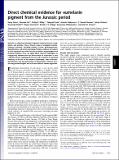Direct chemical evidence for eumelanin pigment from the Jurassic period
Author(s)
Glass, Keely; Ito, Shosuke; Wilby, Philip R.; Sota, Takayuki; Nakamura, Atsushi; Bowers, C. Russell; Vinther, Jakob; Dutta, Suryendu; Briggs, Derek E. G.; Wakamatsu, Kazumasa; Simon, John D.; Summons, Roger E; ... Show more Show less
DownloadSummons-2012-Direct Chemical Evidence for Eumelanin Pigment.pdf (1.125Mb)
PUBLISHER_POLICY
Publisher Policy
Article is made available in accordance with the publisher's policy and may be subject to US copyright law. Please refer to the publisher's site for terms of use.
Terms of use
Metadata
Show full item recordAbstract
Melanin is a ubiquitous biological pigment found in bacteria, fungi, plants, and animals. It has a diverse range of ecological and biochemical functions, including display, evasion, photoprotection, detoxification, and metal scavenging. To date, evidence of melanin in fossil organisms has relied entirely on indirect morphological and chemical analyses. Here, we apply direct chemical techniques to categorically demonstrate the preservation of eumelanin in two > 160 Ma Jurassic cephalopod ink sacs and to confirm its chemical similarity to the ink of the modern cephalopod, Sepia officinalis. Identification and characterization of degradation-resistant melanin may provide insights into its diverse roles in ancient organisms.
Date issued
2012-06Department
Massachusetts Institute of Technology. Department of Earth, Atmospheric, and Planetary SciencesJournal
Proceedings of the National Academy of Sciences
Publisher
National Academy of Sciences
Citation
Glass, K. et al. “Direct Chemical Evidence for Eumelanin Pigment from the Jurassic Period.” Proceedings of the National Academy of Sciences 109.26 (2012): 10218–10223.
Version: Final published version
ISSN
0027-8424
1091-6490